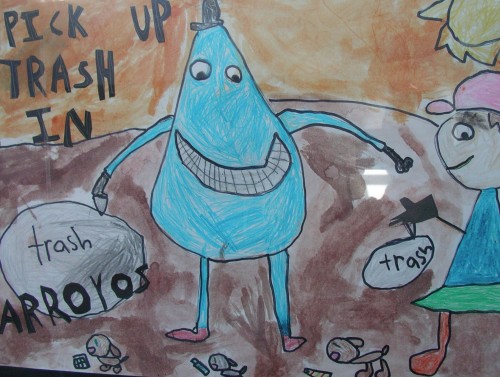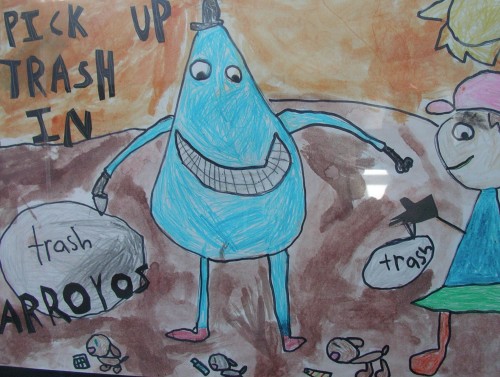 Ed ArchuletaPhoto: Marie GilotBeing president and CEO of a public utility on the U.S.-Mexico border comes with a unique job description. Ed Archuleta, of the El Paso Water Utilities, had to figure out how to make water resources last while sharing them with another country, Mexico, and with another state, New Mexico. Archuleta has been navigating this incredibly complex political environment for 20 years now. During that time, he also managed to implement a nationally recognized water conservation program.
Ed ArchuletaPhoto: Marie GilotBeing president and CEO of a public utility on the U.S.-Mexico border comes with a unique job description. Ed Archuleta, of the El Paso Water Utilities, had to figure out how to make water resources last while sharing them with another country, Mexico, and with another state, New Mexico. Archuleta has been navigating this incredibly complex political environment for 20 years now. During that time, he also managed to implement a nationally recognized water conservation program.
Q. Can you describe what awaited you on your first day on the job those 20 years ago?
A. El Paso had been in a lawsuit with New Mexico over water for 10 years. The [El Paso Public Utilities] board had decided prior to my time to pursue trying to get water from New Mexico and that’s what ended up in a legal battle. When I came in, the board asked me to see whether I could settle the lawsuit and whether there was any other way [to get water].
Q. What did you do?
A. I settled the lawsuit and I ordered a long-term plan to look at our options.
At the top was conservation. We needed to take some of the demand off. Second was to work with the irrigators, to see if we could pick up more water rights (so we could use more surface water from the river). We used to have 90 percent ground water. Now it’s more like 40 percent ground water and 60 percent surface water.
Q. Are relations better with New Mexico?
A. There’s a lot more we could do. I think eventually there will be some kind of partnership between Texas and New Mexico because something has to change. But today, politically, it can’t be done.
Q. Why is that?
A. Water is a protective issue.
Q. So El Paso shares some ground water with New Mexico, but it also shares it with Ciudad Juárez, El Paso’s sister city in Mexico. How do you manage that?
A. There’s no ground water treaty between the U.S. and Mexico so they can pump as much as they want and we can pump as much as we want. They used to pump 100 percent out of the aquifer. When I came on, nobody knew the water folks in Juárez. I said, we have to meet those people, work with them, plan with them. Now they built two primary wastewater treatment plants. They also started conservation even though their consumption per capita is only about half of ours.
Q. Back to conservation. Your early efforts like the watering ordinance met with much resistance from consumers and city representatives, didn’t it?
 El Paso Water Utilities’ educational efforts often target children, hoping they will be the catalysts for change in their homes. Here is the winning poster of a contest urging El Pasoans not to clog natural water drains with trash.Photo courtesy of Marie GilotA. It wasn’t easy. I remember going to a public hearing and I had some people say, “You’re from New Mexico, right?” I said yes. “Well this is Texas. We don’t do this in Texas.”
El Paso Water Utilities’ educational efforts often target children, hoping they will be the catalysts for change in their homes. Here is the winning poster of a contest urging El Pasoans not to clog natural water drains with trash.Photo courtesy of Marie GilotA. It wasn’t easy. I remember going to a public hearing and I had some people say, “You’re from New Mexico, right?” I said yes. “Well this is Texas. We don’t do this in Texas.”
We went through a whole education program.
I went to a lot of meetings — the Rotary club, the Lions Club, Kiwanis, Neighborhood Associations, all kinds of people. We joined the Chamber of Commerce, the Hispanic Chamber of Commerce. I became a member of the Builders’ Association. I was involved in the Symphony.
We set up a 30-person steering committee with people from the community.
We had ads with local personalities. Back then, there was a taboo on spending money on marketing. I had to convince the board that we needed to do education.
We used to do daily reporting in the El Paso Times: How much water we used yesterday. And how did we stand year to date. It was right there with the weather [forecast]. The Times wanted to know, who are the biggest water users in El Paso? And [they] filed open records requests. So when people saw their names in the paper and how much water they used — that’s public information — well, that kind of peer pressure did a lot of good.
As it stands now, I’d be surprised if you found a lot of violations.
Q.Today, consumption is at 134 gallons per person per day, compared with 200 back in 1991, and you are able to produce the same amount of water as you did 20 years ago, even though the population has grown by 250,000 people. Is your work done?
A. No, this is forever. We can’t go back to our old habits. We live in the desert.



